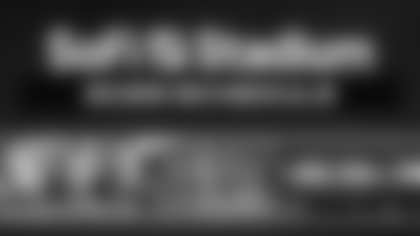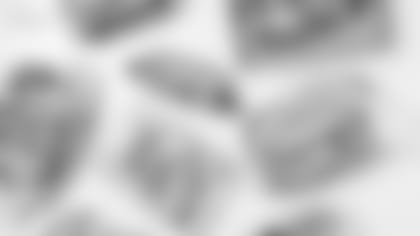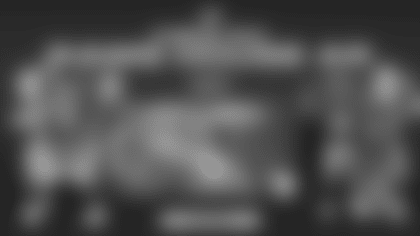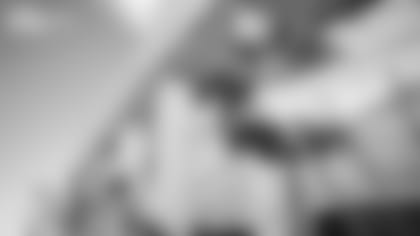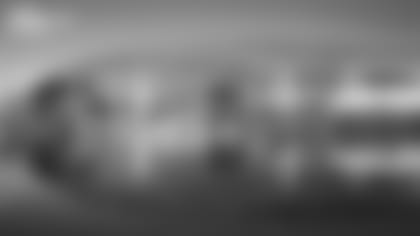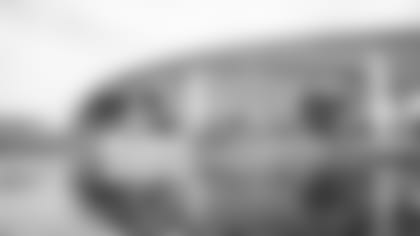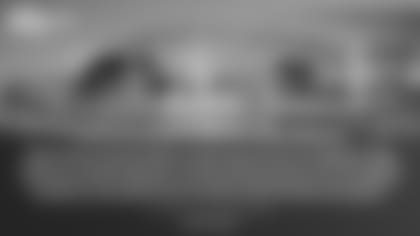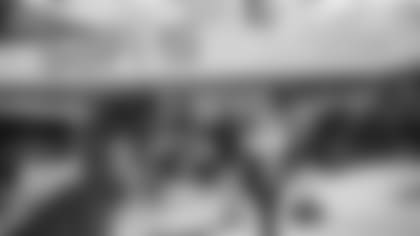After playing on grass at Los Angeles Memorial Coliseum over the last four years, Rams players' cleats will now be digging into Hellas Construction's synthetic Matrix® Turf system this season and beyond.
Laid down at SoFi Stadium earlier this month, the Matrix® Turf with Helix will provide "longevity, playability, and performance (that) is unparalleled in the industry," according to Hellas' website.
"As we were going through the process, it took a couple of years for ownership and the stadium to kind of figure out what they wanted in there, what type of system," James Towsley, Vice President of Business Development for Hellas Construction, told theRams.com in a phone interview this month. "I think it's really because of player safety and performance why they went in our direction."
Also used in the Texans' NRG Stadium and the Cowboys' AT&T Stadium, Matrix Turf with Helix is made up of multiple layers, starting with a Fiber configuration for the surface. The fibers are manufactured in Hellas' fiber factory in Dadeville, Alabama – roughly 25 miles from Auburn.
According to a brochure from Hellas, the Helix technology is similar to the memory and tenacity of a muscle fiber, allowing the turf to "bounce back after repeated use." The shape memory makes each fiber twist, and that twisted monofilament fiber in turn secures the infill to prevent migration and the infill from spraying, creating an aesthetically pleasing playing surface.
"The texturized fiber doesn't reflect light, so it keeps a uniform look more like natural grass," Towsley said.
Next, there is the REALFILL™ Infill with a unique pea gravel base and dust free SBR, cuboidal rubber granules. Per Hellas' website, the base facilitates "proper fiber support, energy restitution, enhanced shock absorption, and rapid drainage" – five crucial attributes for field longevity and player safety.
Energy restitution is defined as the amount of kinetic energy left over when two objects collide. Specific to football, it's important to have a playing surface that returns energy to a player running on it and doesn't slow them down. A common example used to explain this is running on wet sand that is compacted versus dry sand that shifts – you get back more energy from the former than the latter. It's what makes a secure infill and migration prevention by the fiber so important.
As for shock absorption, that's critical for player safety. It serves as a cushion which helps reduce the impact of landing on the turf, like when players are tackled to the ground hard.
Beneath that infill is a triple-player polyurethane backing. This backing is fused with Hellas' Proline® T44 from SIKA to create a tuft-bind, defined as "the force required to pull a 'tuft' out of a carpet, according industry-standard test procedure," per the company's website.
Towsley said the tuft-bind process takes place at the company's textile mill in Chatsworth, Georgia – about 170 miles north of Dadeville. The measurement is crucial for ensuring fibers withstand normal wear and tear over time.
For additional security, turf lock – defined by Hellas as "reinforced rivets that are injected into the turf at every inlay, logo, graphic, and field marking" – is installed. A draining stone foundation represents the last layer.
Collectively, the entire process to assemble the turf – from Dadeville to Chatsworth – took 17 days, according to Towsley. The turf was then sent to Los Angeles to be installed.
When Rams players take the field, they and their fans will have peace of mind about the surface the team will be playing on.
"I think a lot of it really does have to do with quality and its player performance," Towsley said, when asked why the Matrix Turf specifically has been used in some of the NFL's newer venues. "They like a clean interface. And it's us working closely with the NFL, the players association, Biocore and other entities that do testing and clean interface. It's the best playing surface I believe that's out there, and it's artificial turf."



